Delay in the Ripening of Wine Grapes: Effects of Specific Phytotechnical Methods on Harvest Parameters
Abstract
1. Introduction
2. Materials and Methods
2.1. Experimental Site, Vineyard, and Growing Conditions
2.2. Treatments
- LF (leaf removal): the leaves above the cluster zone were removed with a special leaf stripper at veraison (Figure 4);
- ST (short topping): the shoots were trimmed short (60–70 cm) at veraison;
- Control: no treatment was done.
2.3. Experimental Harvest Measures
2.4. Data Analyses
3. Results
3.1. Yield
3.2. Sugar Content of Grape Juice
3.3. Titratable Acidity of Grape Juice
3.4. The pH Value of the Grape Juice
3.5. Rate of Botrytis Infection
3.6. Cultivar-Wise Analyses
3.6.1. Pinot Noir
3.6.2. Welshriesling
4. Discussion
5. Conclusions
Author Contributions
Funding
Data Availability Statement
Conflicts of Interest
References
- IPCC. Summary for Policymakers. In Climate Change 2022: Mitigation of Climate Change. Contribution of Working Group III to the Sixth Assessment Report of the Intergovernmental Panel on Climate Change; Shukla, P.R., Skea, J., Slade, R., al Khourdajie, A., van Diemen, R., McCollum, D., Pathak, M., Some, S., Vyas, P., Fradera, R., et al., Eds.; Cambridge University Press: Cambridge, UK; New York, NY, USA, 2022. [Google Scholar]
- Schultz, H.R. Climate Change and Viticulture: A European Perspective on Climatology, Carbon Dioxide and UV-B Effects. Aust. J. Grape Wine Res. 2000, 6, 2–12. [Google Scholar] [CrossRef]
- Tate, A.B. Global Warming’s Impact on Wine. Int. J. Phytoremediation 2001, 21, 95–109. [Google Scholar] [CrossRef]
- Petgen, M. Reaktion Der Reben Auf Den Klimawandel. Schweiz. Z. Obst-Weinbau 2007, 9, 6–9. [Google Scholar]
- Prior, B. Bestandsführung an Klimawandel Anpassen. Das. Deutsche. Weinmagazin 2007, 10, 22–27. [Google Scholar]
- Becker, N.J. Einfluss von Standortfaktoren Auf Beerenreifung Und Ertragsbildung. Die. Wein-Wissenschaft 1985, 40, 291–318. [Google Scholar]
- Kenny, G.J.; Shao, J. An Assessment of a Latitude-Temperature Index for Predicting Climate Suitability for Grapes in Europe. J. Hortic. Sci. 2015, 67, 239–246. [Google Scholar] [CrossRef]
- Kenny, G.J.; Harrison, P.A. The Effects of Climate Variability and Change on Grape Suitability in Europe. J. Wine Res. 2007, 3, 163–183. [Google Scholar] [CrossRef]
- Jones, G.V.; Webb, L.B. Climate Change, Viticulture, and Wine: Challenges and Opportunities. J. Wine Res. 2010, 21, 103–106. [Google Scholar] [CrossRef]
- Vršic, S.; Vodovnik-Plevnik, T. Reactions of Vines Varieties to Climate Changes in NE Slovenia. Plant Soil Env. 2012, 58, 34–41. [Google Scholar] [CrossRef]
- Webb, L.B.; Whetton, P.H.; Barlow, E.W.R. Observed Trends in Winegrape Maturity in Australia. Glob. Chang. Biol. 2011, 17, 2707–2719. [Google Scholar] [CrossRef]
- Jorquera-Fontena, E.; Orrego, R. Impact of Global Warming on the Phenology of a Variety of Grapevine Grown in Southern Chile. Agrociencia 2010, 44, 427–435. [Google Scholar]
- Duchêne, E.; Schneider, C. Grapevine and Climatic Changes: A Glance at the Situation in Alsace. Agron. Sustain. Dev. 2005, 25, 93–99. [Google Scholar] [CrossRef]
- Duchêne, E.; Huard, F.; Dumas, V.; Schneider, C.; Merdinoglu, D. The Challenge of Adapting Grapevine Varieties to Climate Change. Clim. Res. 2010, 41, 193–204. [Google Scholar] [CrossRef]
- Van Leeuwen, C.; Schultz, H.R.; De Cortazar-Atauri, I.G.; Duchêne, E.; Ollat, N.; Pieri, P.; Bois, B.; Goutouly, J.P.; Quénol, H.; Touzard, J.M.; et al. Why Climate Change Will Not Dramatically Decrease Viticultural Suitability in Main Wine-Producing Areas by 2050. Proc. Natl. Acad. Sci. USA 2013, 110, 3051–3052. [Google Scholar] [CrossRef]
- Hannah, L.; Roehrdanz, P.R.; Ikegami, M.; Shepard, A.V.; Shaw, M.R.; Tabor, G.; Zhi, L.; Marquet, P.A.; Hijmans, R.J. Climate Change, Wine, and Conservation. Proc. Natl. Acad. Sci. USA 2013, 110, 6907–6912. [Google Scholar] [CrossRef]
- Hannah, L.; Roehrdanz, P.R.; Ikegami, M.; Shepard, A.V.; Shaw, M.R.; Tabor, G.; Zhi, L.; Marquet, P.A.; Hijmans, R.J. Reply to van Leeuwen et al. Planning for Agricultural Adaptation to Climate Change and Its Consequences for Conservation. Proc. Natl. Acad. Sci. USA 2013, 110, 3053. [Google Scholar] [CrossRef]
- Mesterházy, I.; Mészáros, R.; Pongrácz, R. The Effects of Climate Change on Grape Production in Hungary. Időjárás-Q. J. Hung. Meteorol. Serv. 2014, 118, 193–206. [Google Scholar]
- Mesterházy, I.; Pongrácz, R.; Köbölkuti, Z.A.; Ladányi, M. Predicted Changes of Grape Production Indicators Refined by Modified Growing Season Calculation Method (1951–2100), Hungary In Módosított Vegetációs Időszak-Számítási Módszerrel Korrigált Szőlőtermesztési Indikátorok Várható Változása Magyarországon (1951–2100); Erdélyi Múzeum-Egyesület: Cluj-Napoca, Romania, 2016. [Google Scholar]
- Mesterházy, I.; Mészáros, R.; Pongrácz, R.; Bodor, P.; Ladányi, M. The Analysis of Climatic Indicators Using Different Growing Season Calculation Methods–An Application to Grapevine Grown in Hungary. Idojaras 2018, 122, 217–235. [Google Scholar] [CrossRef]
- Irimia, L.; Tardea, C.; Niculaua, M.; Rotaru, L. Influence of Canopy on Must and Wine Quality in The Zweigelt Variety. Rev. Lucr. Ştiinţifice USAMV Iaşi-Ser. Hortic. 2007, 50, 439–444. [Google Scholar]
- Borghezan, M.; Pit, F.A.; Gavioli, O.; Malinovski, L.I.; Silva, A.L. Canopy Management on Ripening of ‘Sauvignon Blanc’ Grapevine Grown in São Joaquim, Brazil. Acta. Hortic. 2017, 1188, 83–90. [Google Scholar] [CrossRef]
- Minnaar, P.P.; Jolly, N.P.; Ntushelo, N.S. Effect of Grapevine Canopy Side on Selected Sensory Attributes of Pinotage and Cabernet Sauvignon Wines. S. Afr. J. Enol. Vitic. 2020, 41, 1–7. [Google Scholar] [CrossRef]
- Gao, X.T.; Sun, D.; Wu, M.H.; Li, H.Q.; Liu, F.Q.; He, F.; Pan, Q.H.; Wang, J. Influence of Cluster Positions in the Canopy and Row Orientation on the Flavonoid and Volatile Compound Profiles in Vitis vinifera L. Cabernet Franc and Chardonnay Berries. Food Res. Int. 2021, 143, 110306. [Google Scholar] [CrossRef]
- Fanny, P.; Raymond, N.; Feilhes, C.; Prezman, F.; Pasquier, G.; Saccharin, P.; Mille, B.; Bulon, E.; Dufourcq, T. Reducing Alcohol Content in Wines by Combining Canopy Management Practices and Biological Techniques. 2018. Available online: https://www.researchgate.net/publication/325949419_Reducing_alcohol_content_in_wines_by_combining_canopy_management_practices_and_biological_techniques (accessed on 20 July 2023).
- Gambacorta, G.; Faccia, M.; Natrella, G.; Noviello, M.; Masi, G.; Tarricone, L. Early Basal Leaf Removal at Different Sides of the Canopy Improves the Quality of Aglianico Wine. Foods 2022, 11, 3140. [Google Scholar] [CrossRef]
- Zhang, P.; Wu, X.; Needs, S.; Liu, D.; Fuentes, S.; Howell, K. The Influence of Apical and Basal Defoliation on the Canopy Structure and Biochemical Composition of Vitis vinifera Cv. Shiraz Grapes and Wine. Front. Chem. 2017, 5, 48. [Google Scholar] [CrossRef]
- Wobbrock, J.O.; Findlater, L.; Gergle, D.; Higgins, J.J. The Aligned Rank Transform for Nonparametric Factorial Analyses Using Only ANOVA Procedures. Conf. Hum. Factors Comput. Syst.-Proc. 2011, 143–146. [Google Scholar] [CrossRef]
- Elkin, L.A.; Kay, M.; Higgins, J.J.; Wobbrock, J.O. An Aligned Rank Transform Procedure for Multifactor Contrast Tests. In Proceedings of the UIST 2021-Proceedings of the 34th Annual ACM Symposium on User Interface Software and Technology, New York, NY, USA, 10–14 October 2021; pp. 754–768. [Google Scholar] [CrossRef]
- R Core Team. R: A Language and Environment for Statistical Computing; R Foundation for Statistical Computing: Vienna, Austria; Available online: http://www.r-project.org/ (accessed on 12 January 2023).
- Data Visualization with R and Ggplot2|the R Graph Gallery. Available online: https://r-graph-gallery.com/ggplot2-package.html (accessed on 28 February 2023).
- Nakasato, N.; Mori, M.; Ichi Nomoto, K.; Zhang, D.; Zhang, Y.; Lin, K.; Guseynov, S.N.; Mayborodin, S.V. Photosynthesis Productivity and Architectonics of the Crystal Grape Variety Canopy with Different Techniques of Training and Forming Grape Bushes. IOP Conf. Ser. Earth Environ. Sci. 2021, 624, 012055. [Google Scholar] [CrossRef]
- Raghavendra, A.S. Photosynthesis and Partitioning|C3 Plants. In Encyclopedia of Applied Plant Sciences; Elsevier: Amsterdam, The Netherlands, 2003; pp. 673–680. ISBN 978-0-12-227050-5. [Google Scholar]
- Murakami, K. Global Maps of Canopy Photosynthesis of Wine Grape under Changing Climate. Res. Sq. 2023, unpublished. [Google Scholar] [CrossRef]
- Koufos, G.C.; Mavromatis, T.; Koundouras, S.; Jones, G.V. Adaptive Capacity of Winegrape Varieties Cultivated in Greece to Climate Change: Current Trends and Future Projections. OENO One 2020, 54, 1201–1219. [Google Scholar] [CrossRef]
- Poni, S.; Bernizzoni, F.; Civardi, S.; Libelli, N. Effects of Pre-Bloom Leaf Removal on Growth of Berry Tissues and Must Composition in Two Red Vitis vinifera L. Cultivars. Aust. J. Grape Wine Res. 2009, 15, 185–193. [Google Scholar] [CrossRef]
- Van Leeuwen, C.; Destrac-Irvine, A.; Dubernet, M.; Duchêne, E.; Gowdy, M.; Marguerit, E.; Pieri, P.; Parker, A.; De Rességuier, L.; Ollat, N. An Update on the Impact of Climate Change in Viticulture and Potential Adaptations. Agronomy 2019, 9, 514. [Google Scholar] [CrossRef]
- Kliewer, W.M.; Dokoozlian, N.K. Leaf Area/Crop Weight Ratios of Grapevines: Influence on Fruit Composition and Wine Quality. Am. J. Enol. Vitic. 2005, 56, 170–181. [Google Scholar] [CrossRef]
- Parker, A.K.; Hofmann, R.W.; van Leeuwen, C.; Mclachlan, A.R.G.; Trought, M.C.T. Leaf Area to Fruit Mass Ratio Determines the Time of Veraison in Sauvignon Blanc and Pinot Noir Grapevines. Aust. J. Grape Wine Res. 2014, 20, 422–431. [Google Scholar] [CrossRef]
- Parker, A.K.; Hofmann, R.W.; van Leeuwen, C.; Mclachlan, A.R.G.; Trought, M.C.T. Manipulating the Leaf Area to Fruit Mass Ratio Alters the Synchrony of Total Soluble Solids Accumulation and Titratable Acidity of Grape Berries. Aust. J. Grape Wine Res. 2015, 21, 266–276. [Google Scholar] [CrossRef]
- Chemical, J.; Han, S.; Yang, J.; Choi, K.; Kim, J.; Adhikari, K.; Lee, J. Chemical Analysis of Commercial White Wines and Its Relationship with Consumer Acceptability. Foods 2022, 11, 603. [Google Scholar] [CrossRef]
- Poni, S.; Gatti, M.; Bernizzoni, F.; Civardi, S.; Bobeica, N.; Magnanini, E.; Palliotti, A. Late Leaf Removal Aimed at Delaying Ripening in Cv. Sangiovese: Physiological Assessment and Vine Performance. Aust. J. Grape Wine Res. 2013, 19, 378–387. [Google Scholar] [CrossRef]
- Palliotti, A.; Panara, F.; Silvestroni, O.; Lanari, V.; Sabbatini, P.; Howell, G.S.; Gatti, M.; Poni, S. Influence of Mechanical Postveraison Leaf Removal Apical to the Cluster Zone on Delay of Fruit Ripening in Sangiovese (Vitis vinifera L.) Grapevines. Aust. J. Grape Wine Res. 2013, 19, 369–377. [Google Scholar] [CrossRef]
- De Bei, R.; Wang, X.; Papagiannis, L.; Cocco, M.; O’Brien, P.; Zito, M.; Ouyang, J.; Fuentes, S.; Gilliham, M.; Tyerman, S.; et al. Postveraison Leaf Removal Does Not Consistently Delay Ripening in Semillon and Shiraz in a Hot Australian Climate. Am. J. Enol. Vitic. 2019, 70, 398–410. [Google Scholar] [CrossRef]
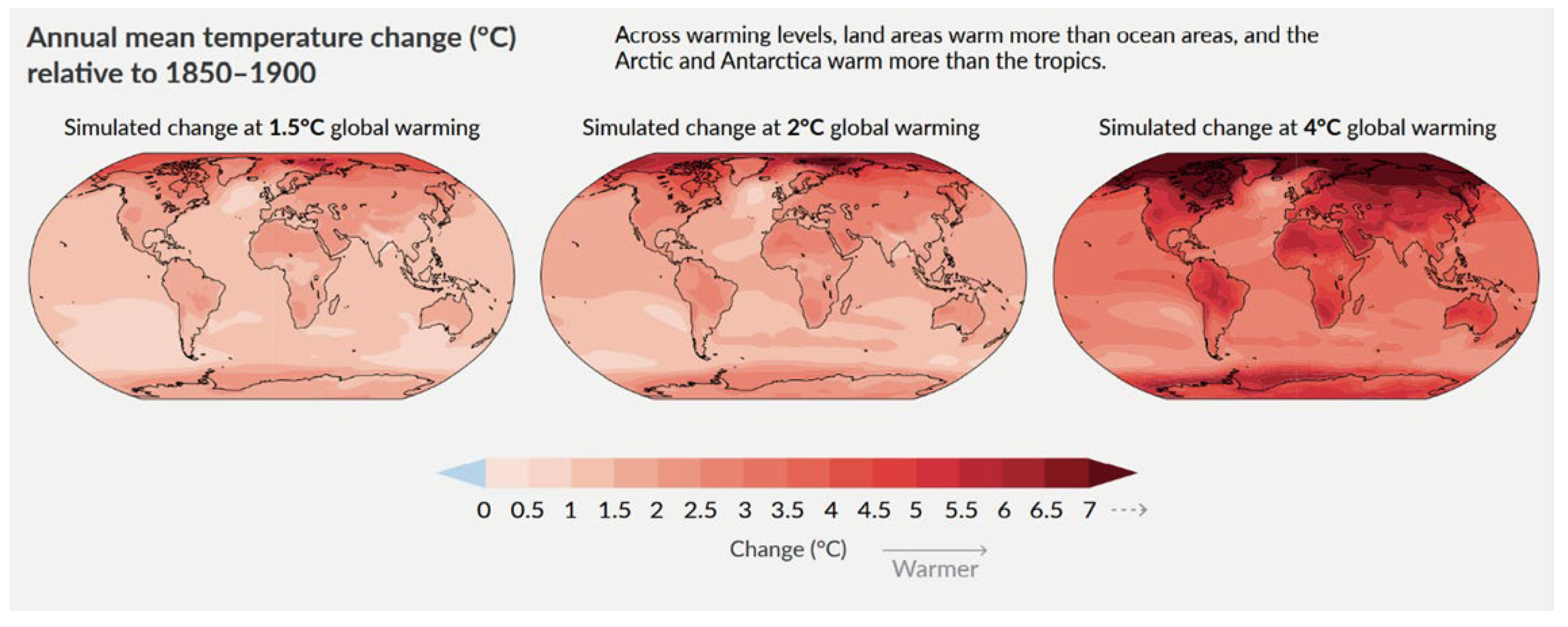
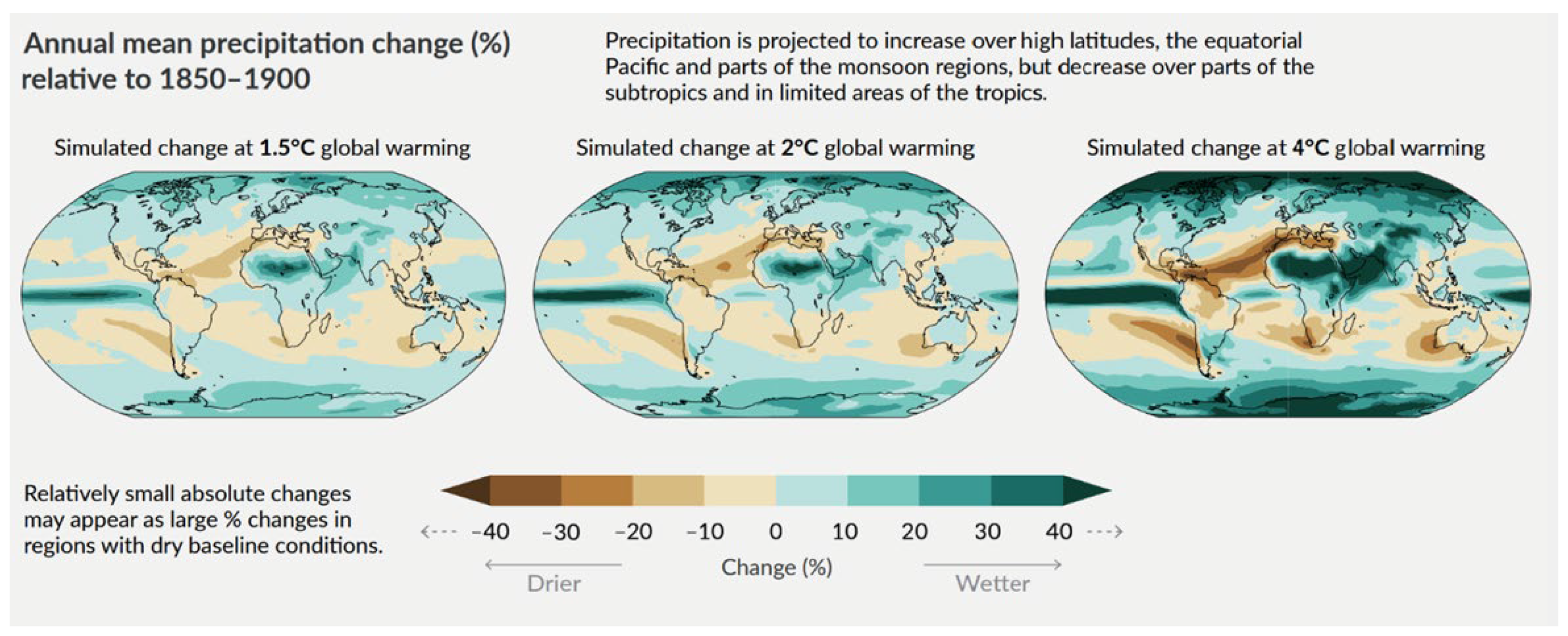
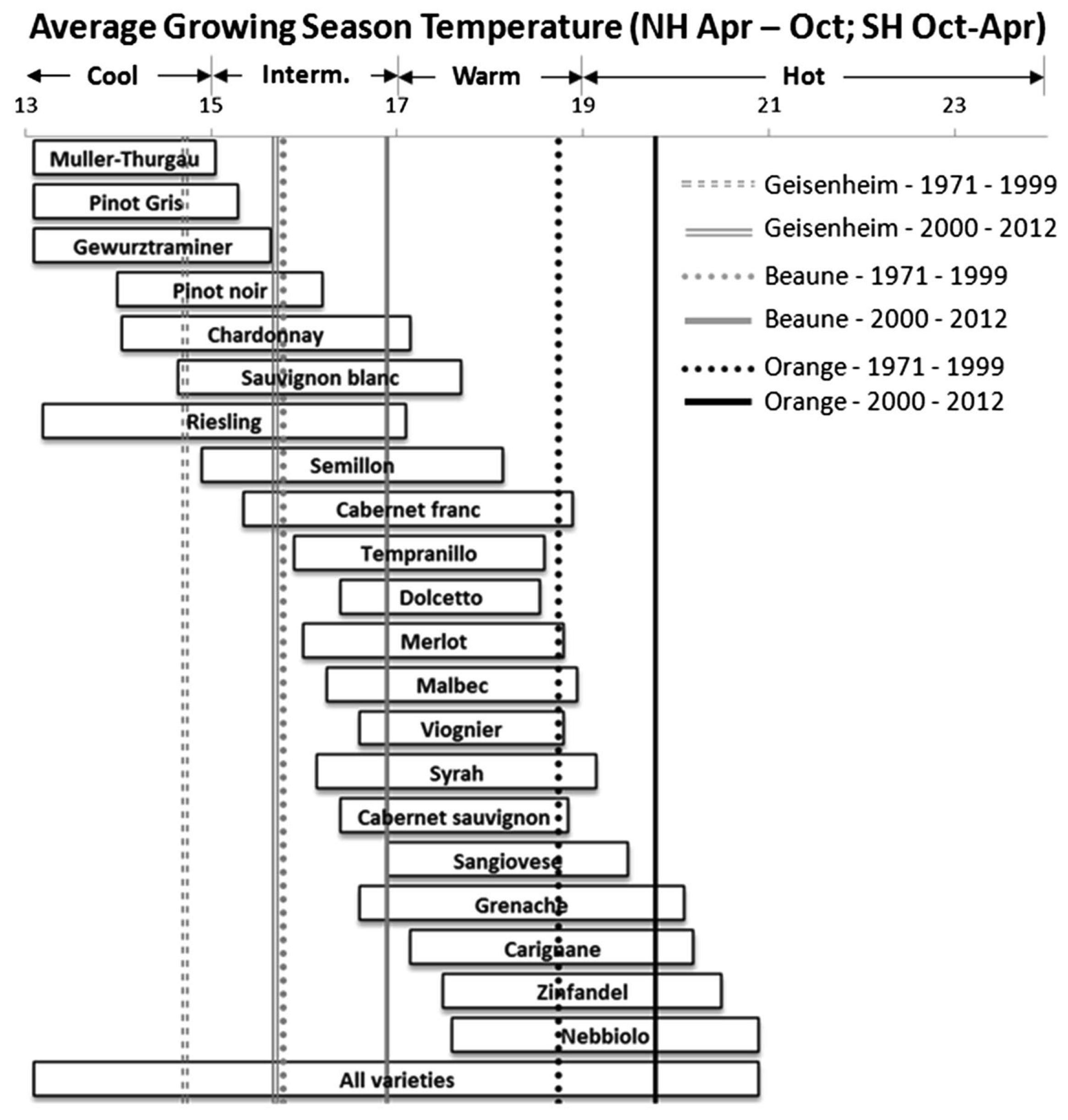
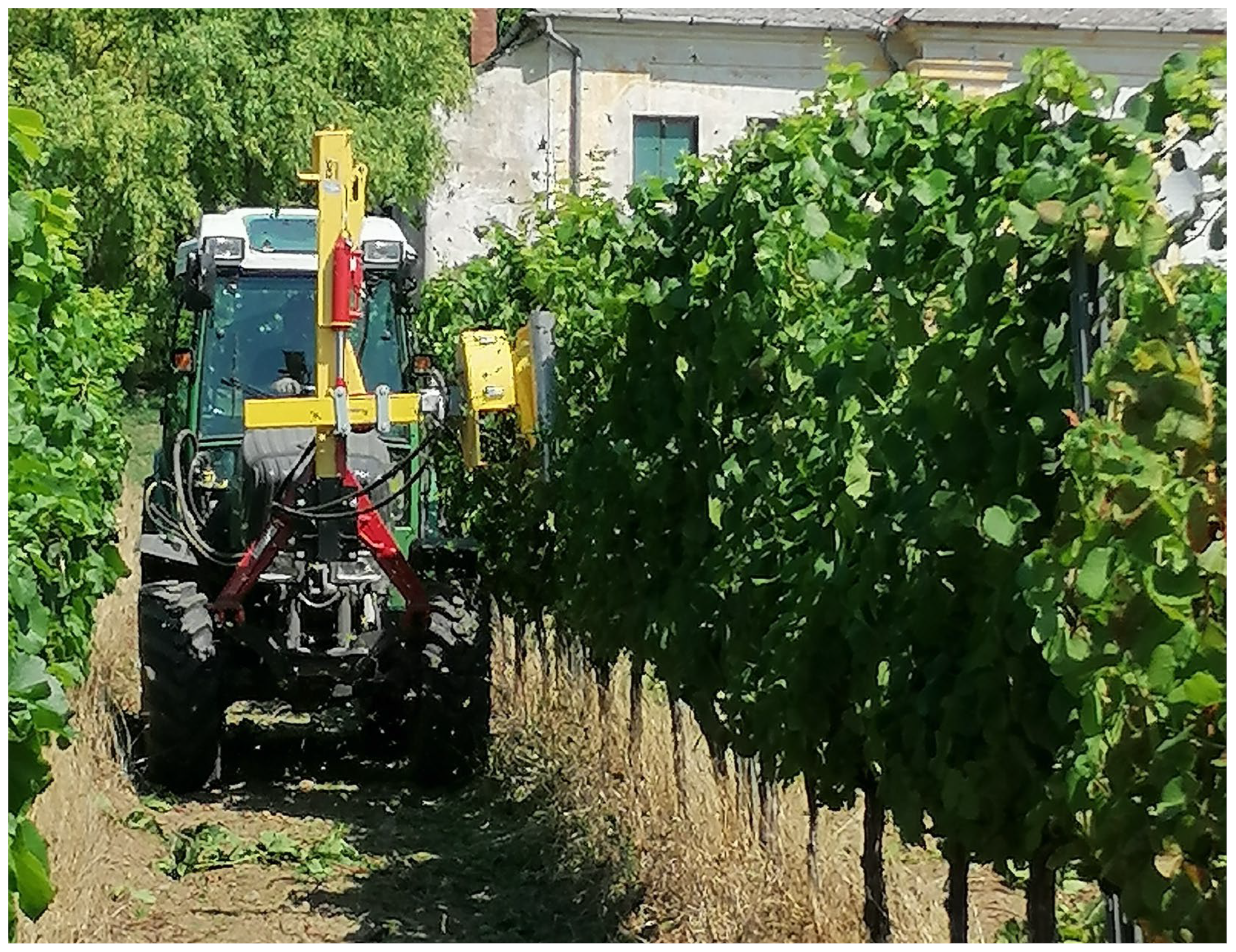
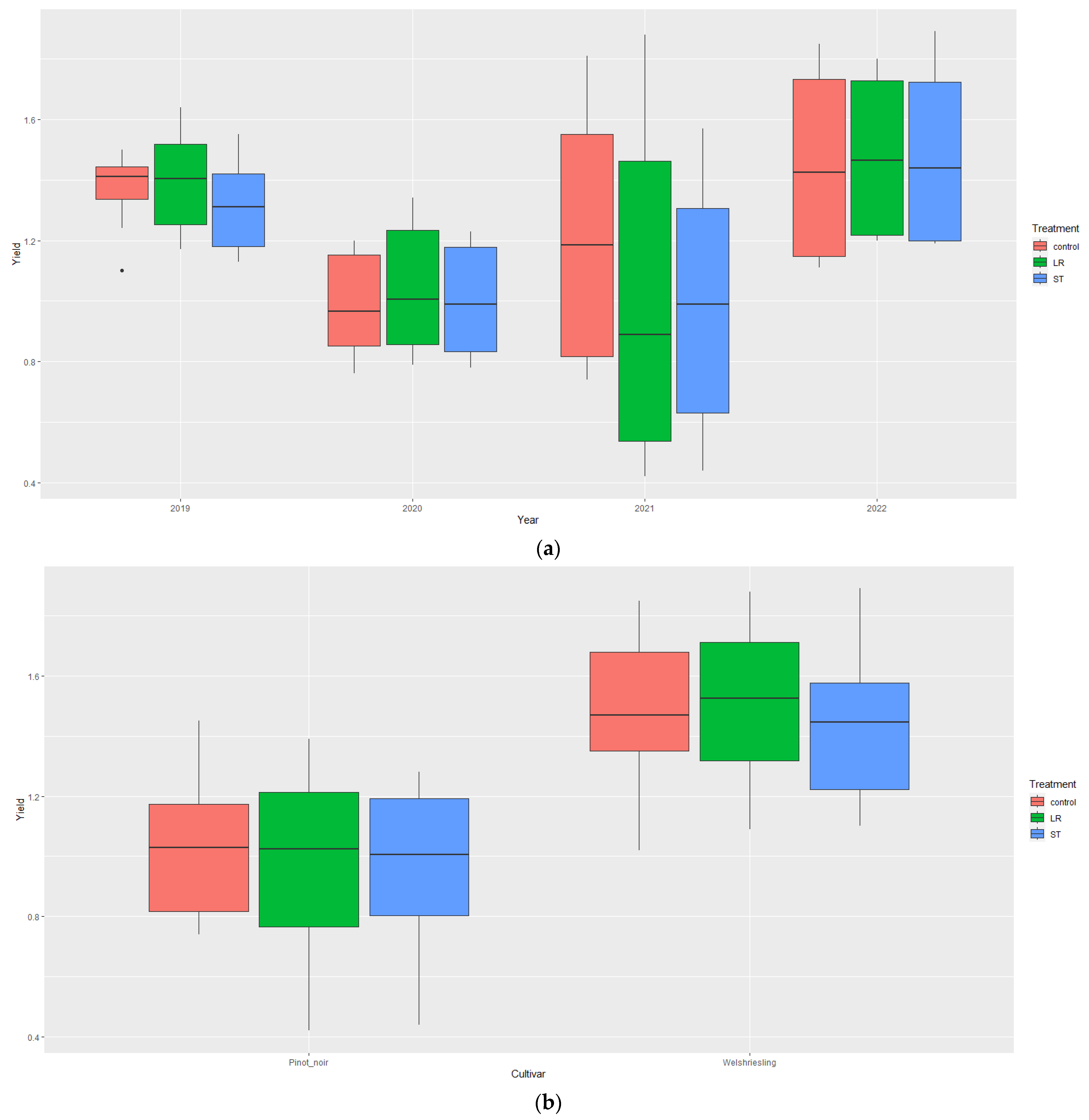
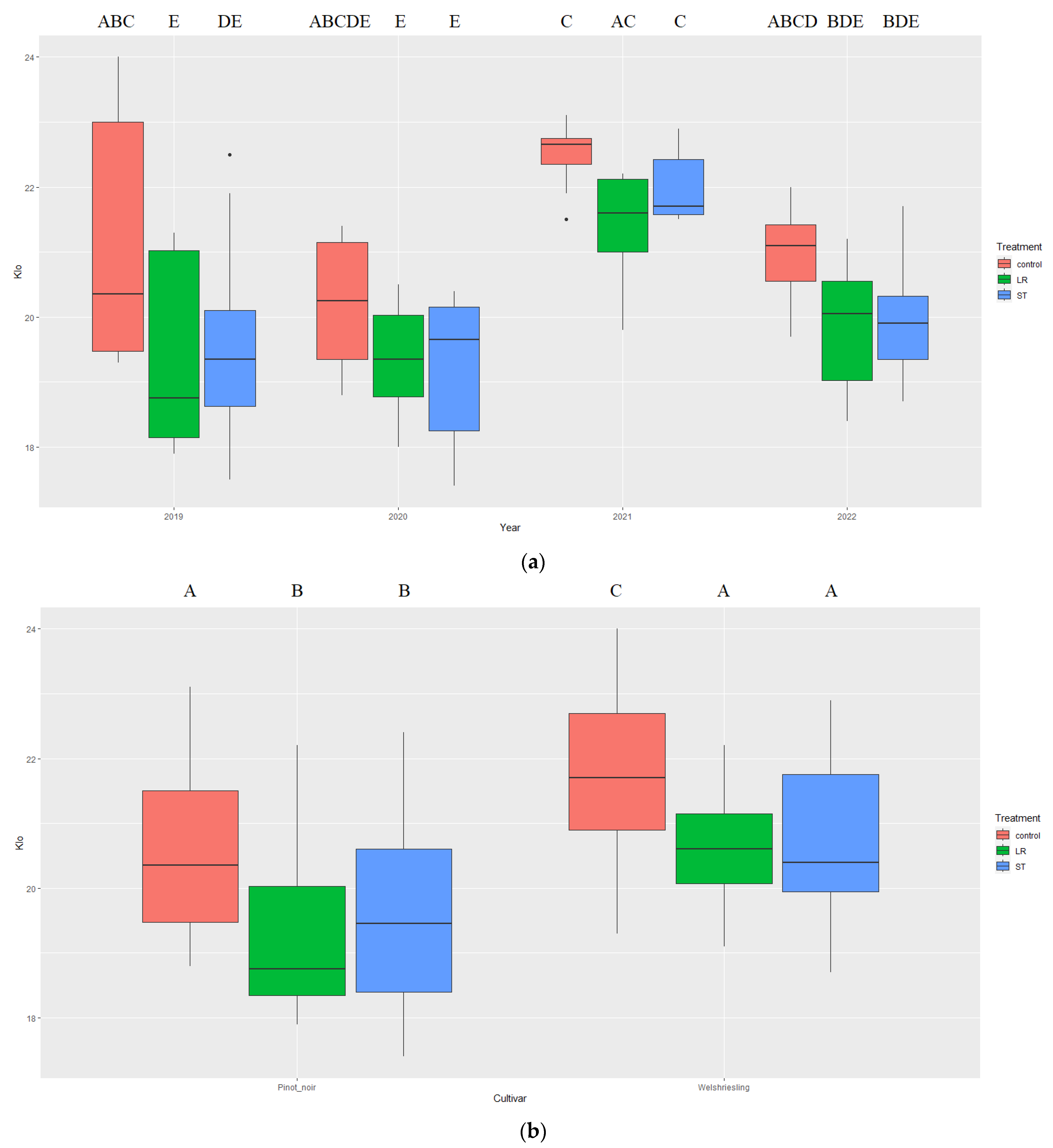
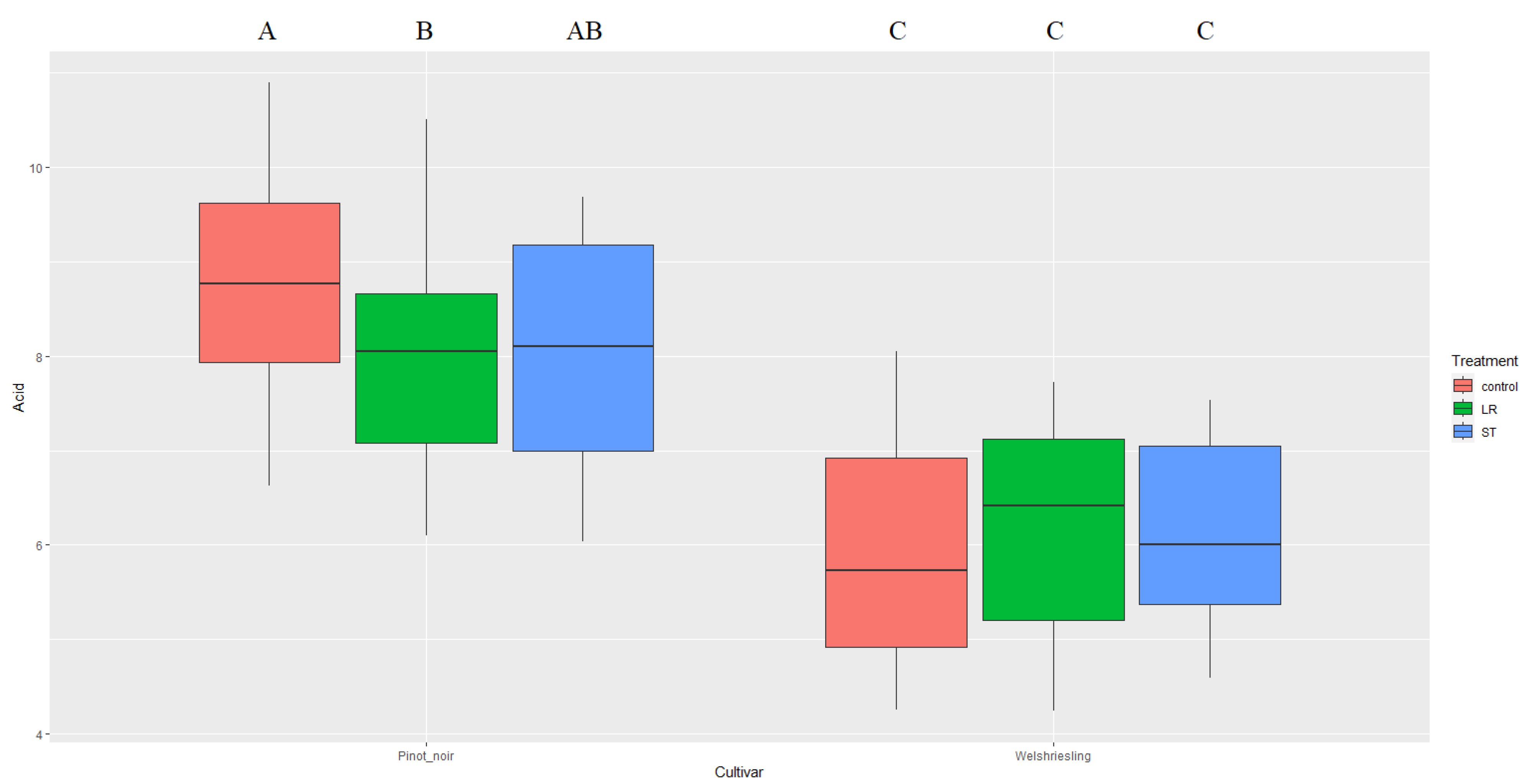
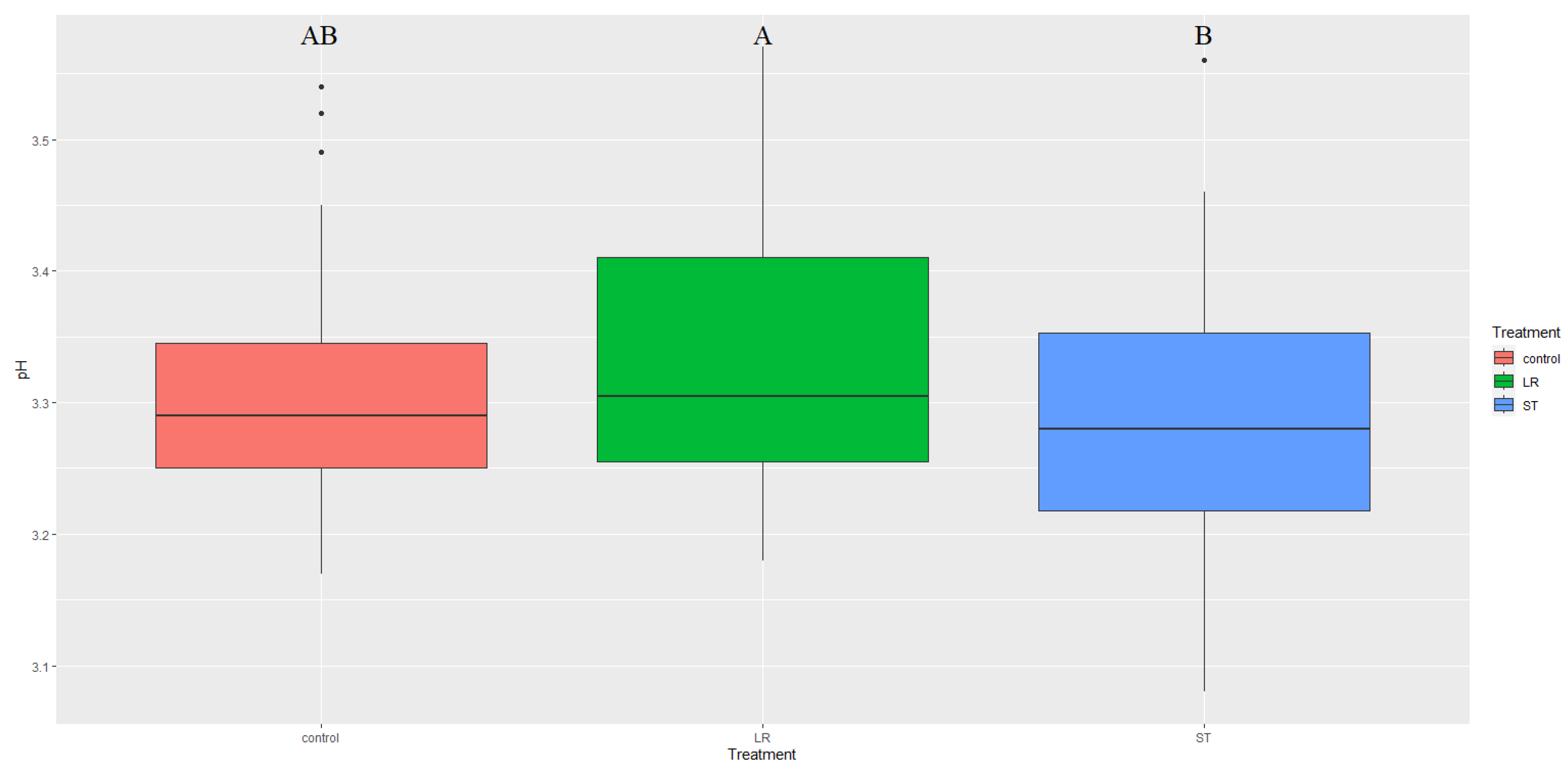
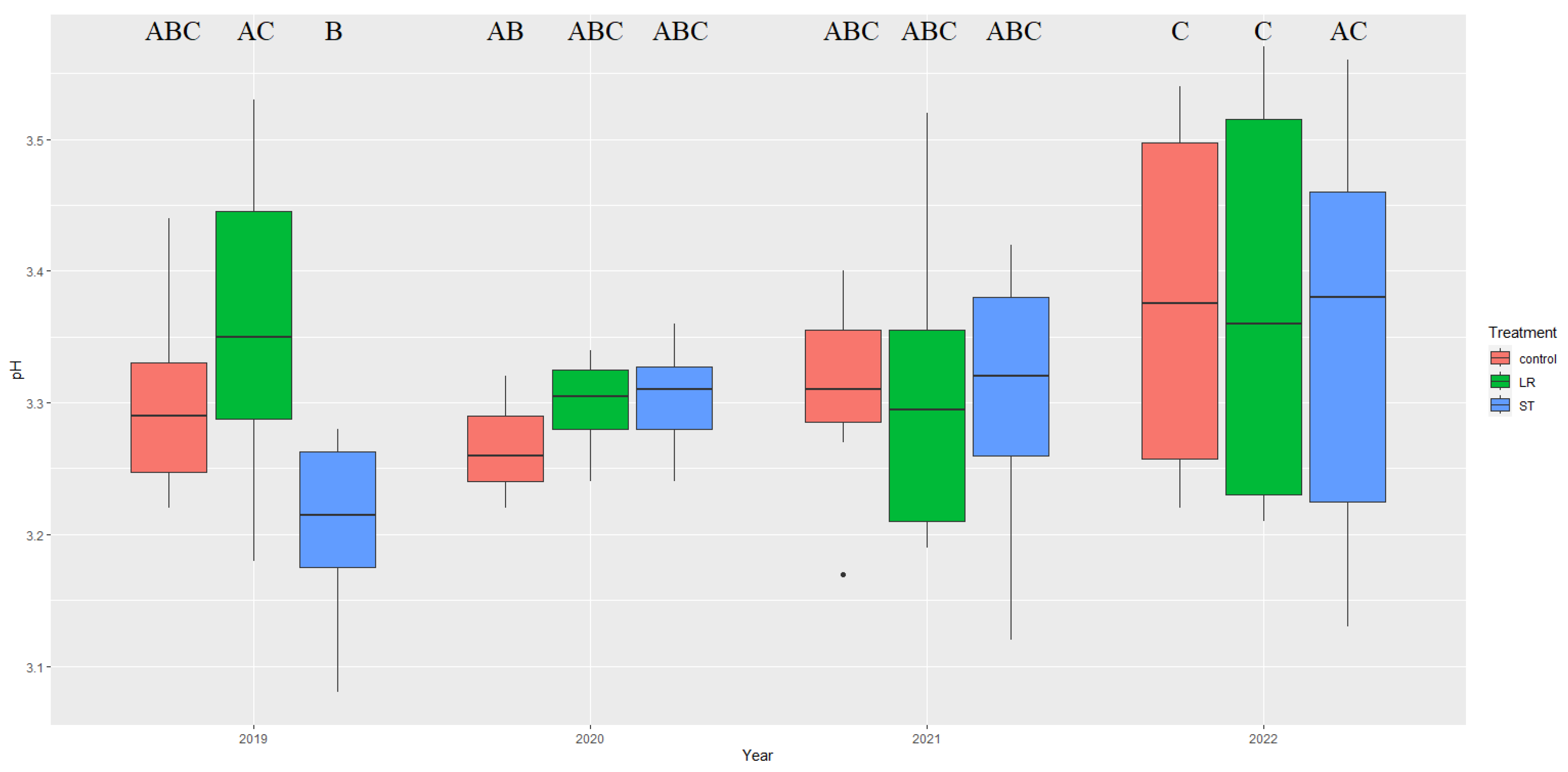
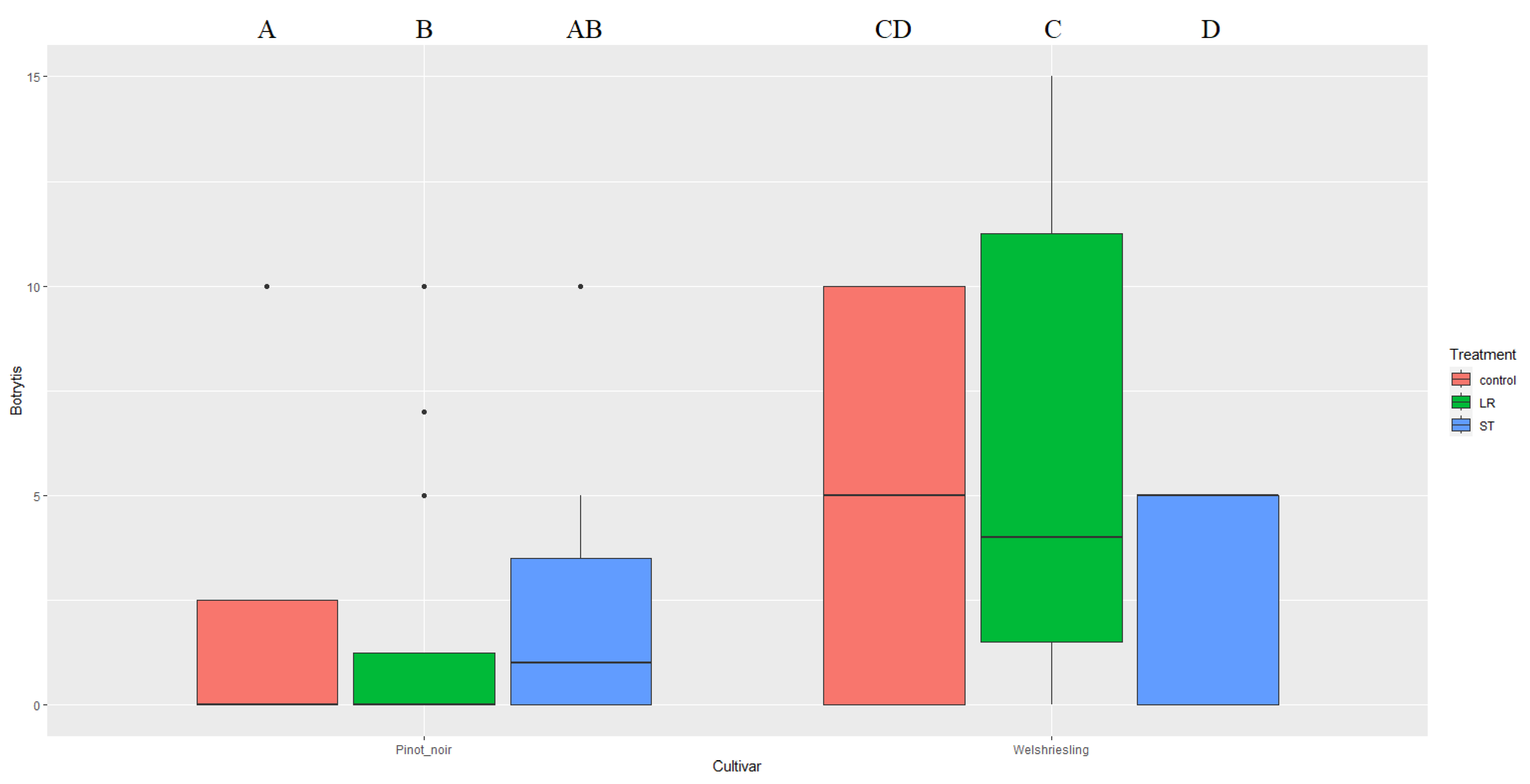
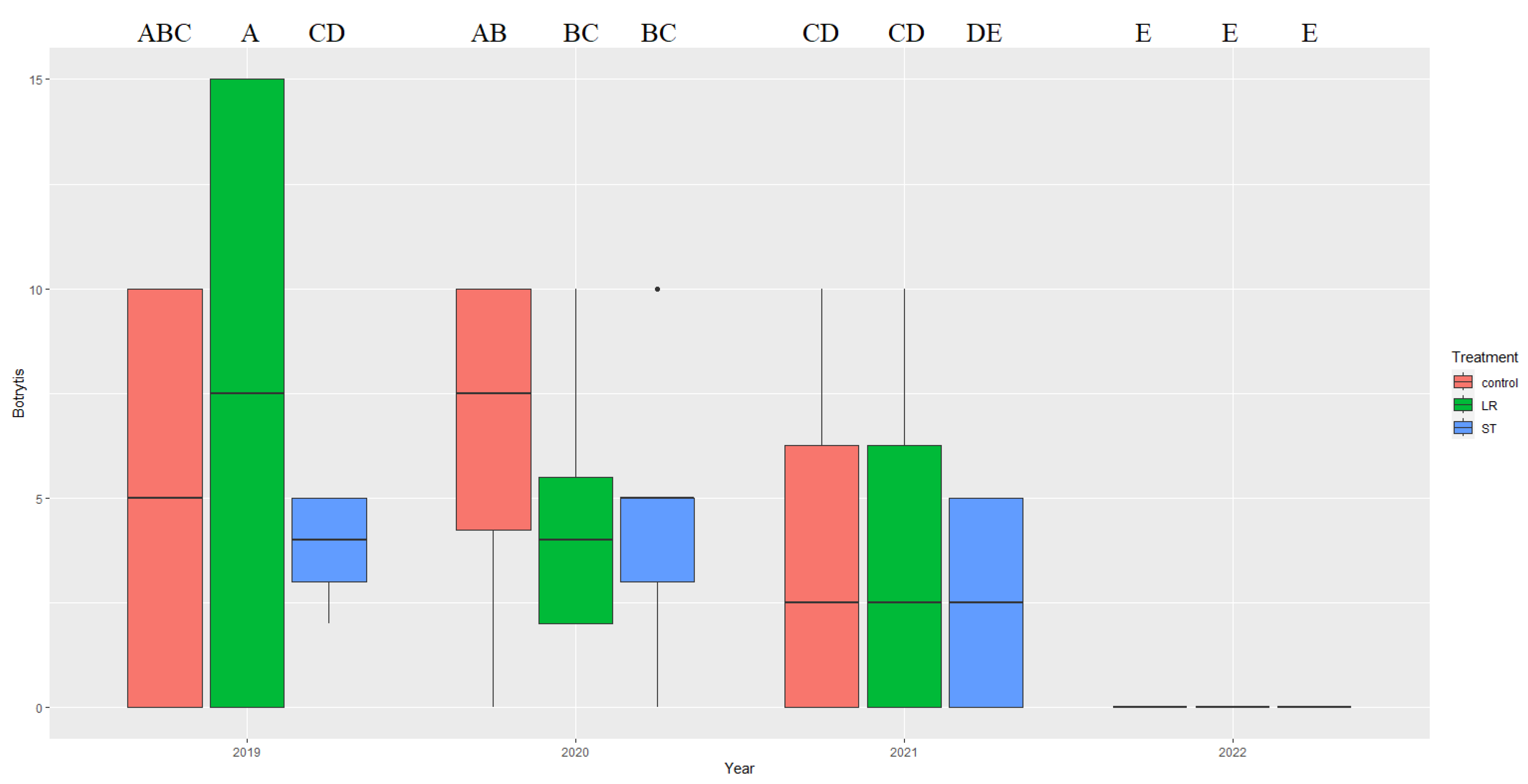
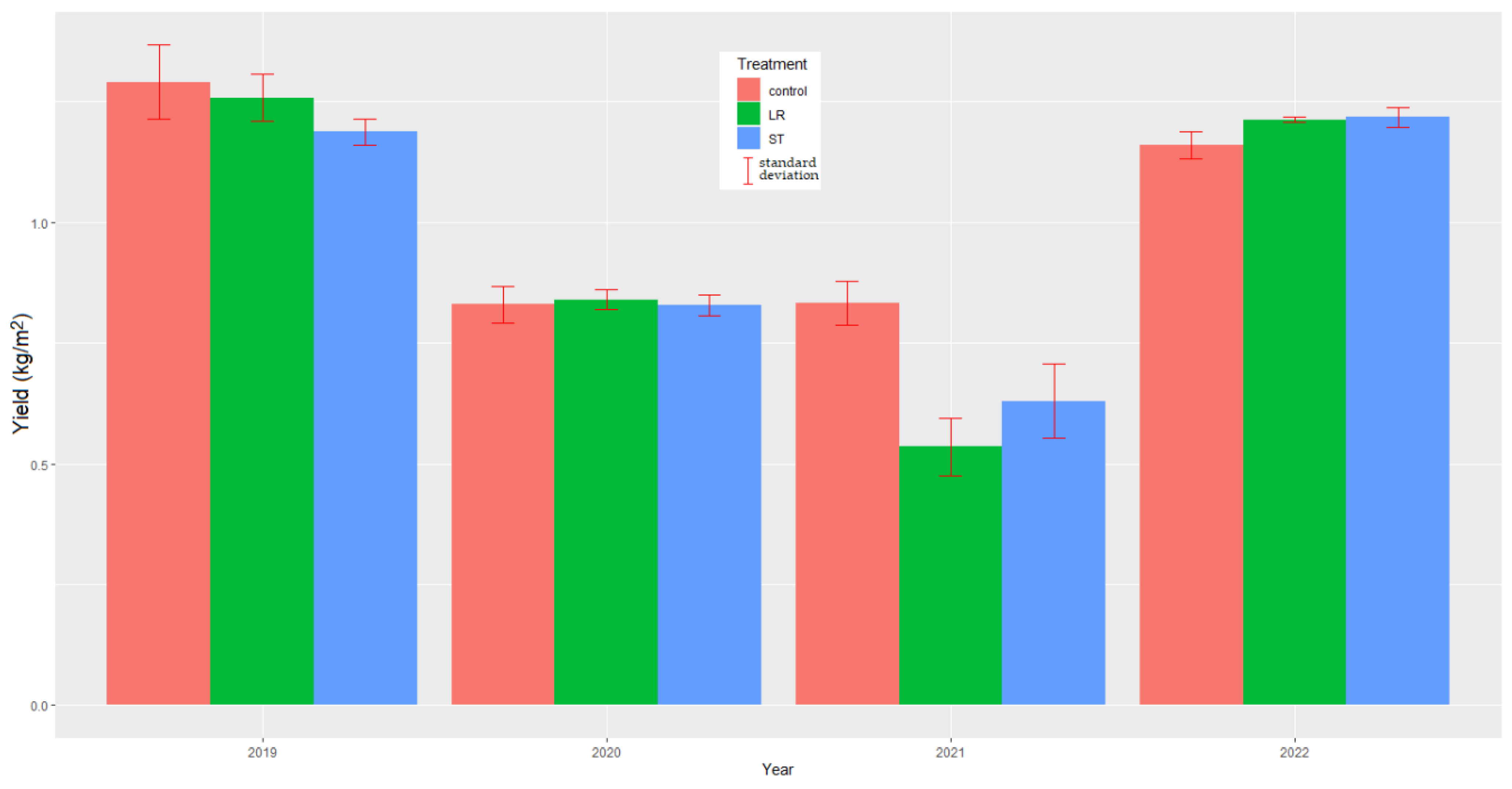
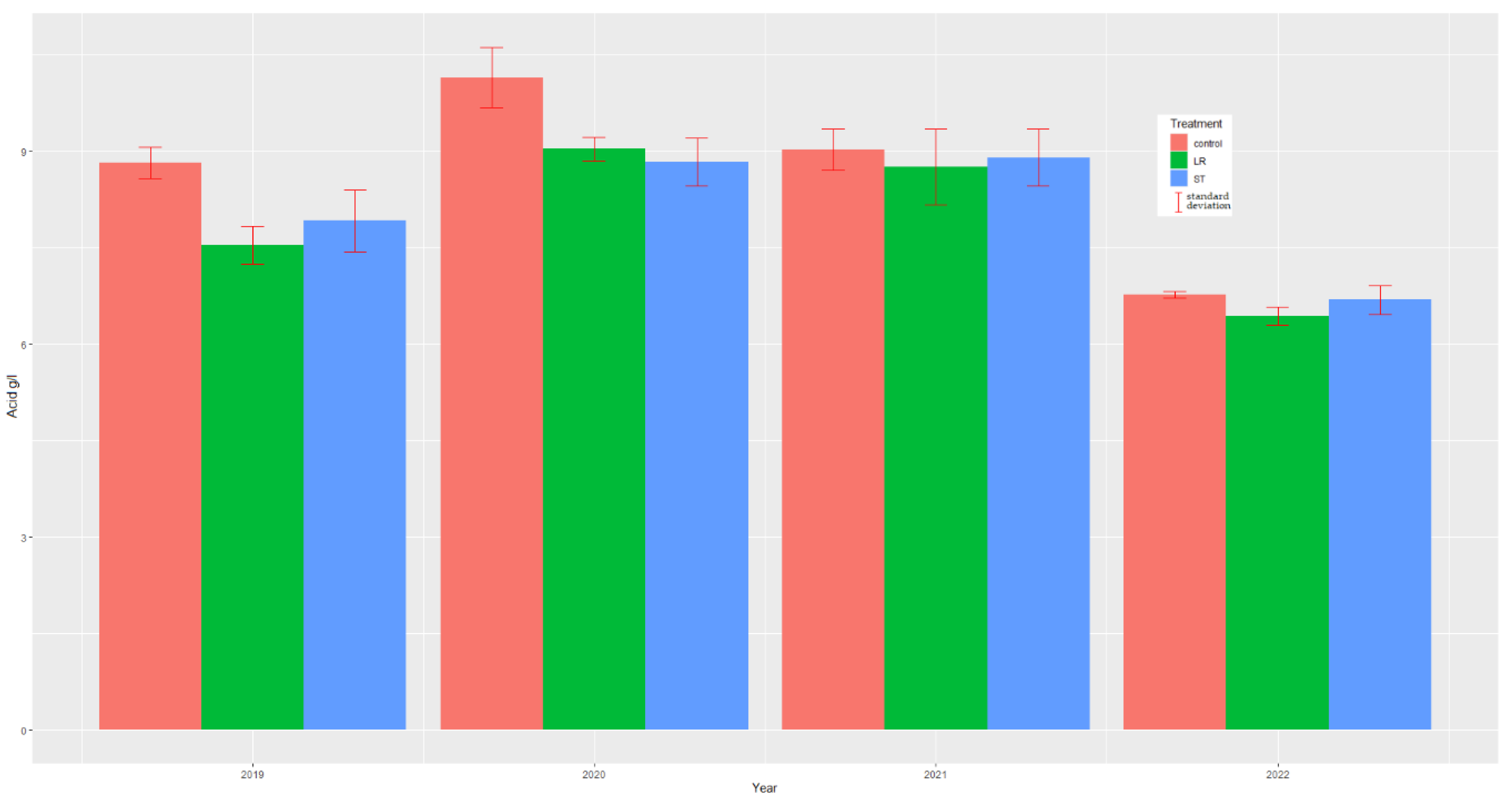
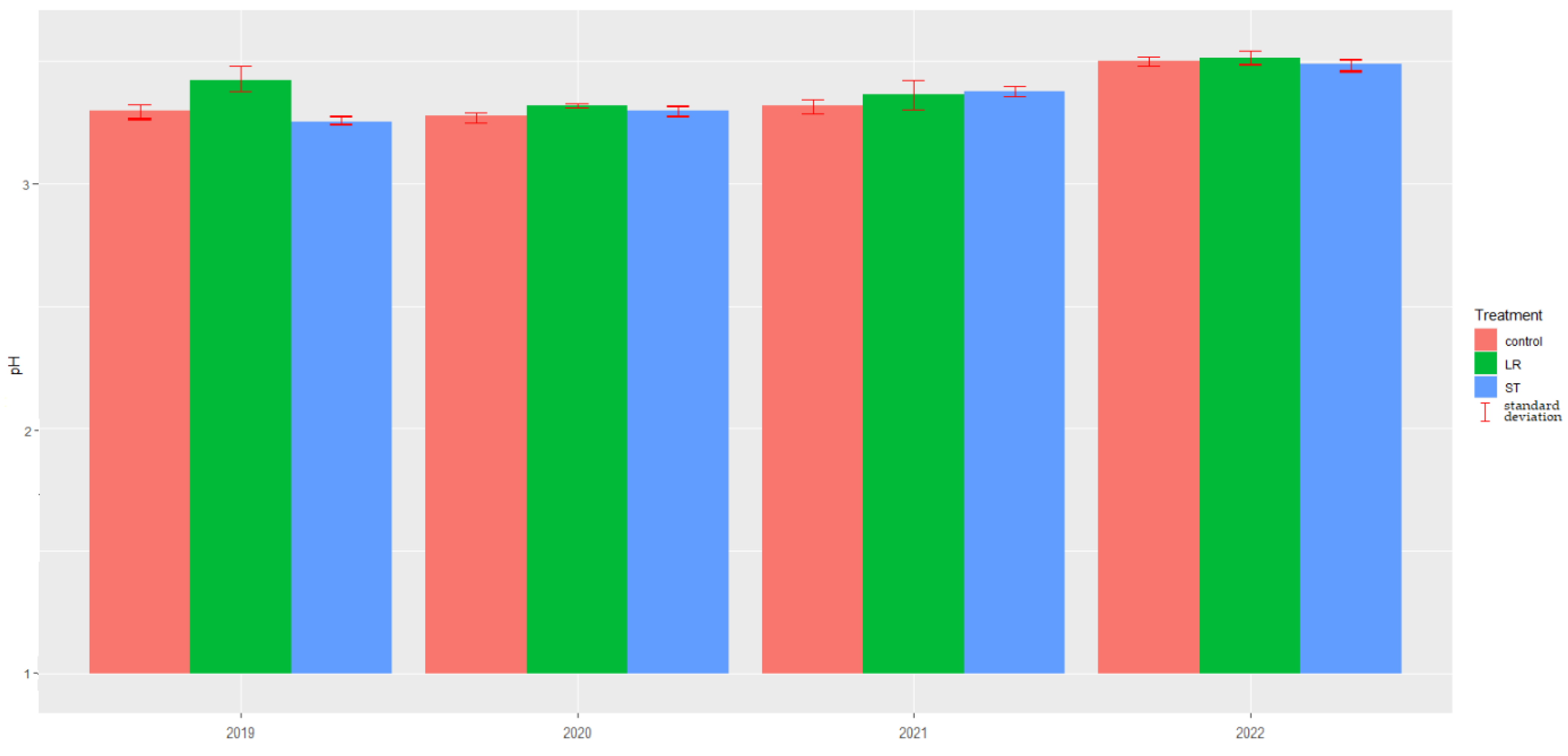
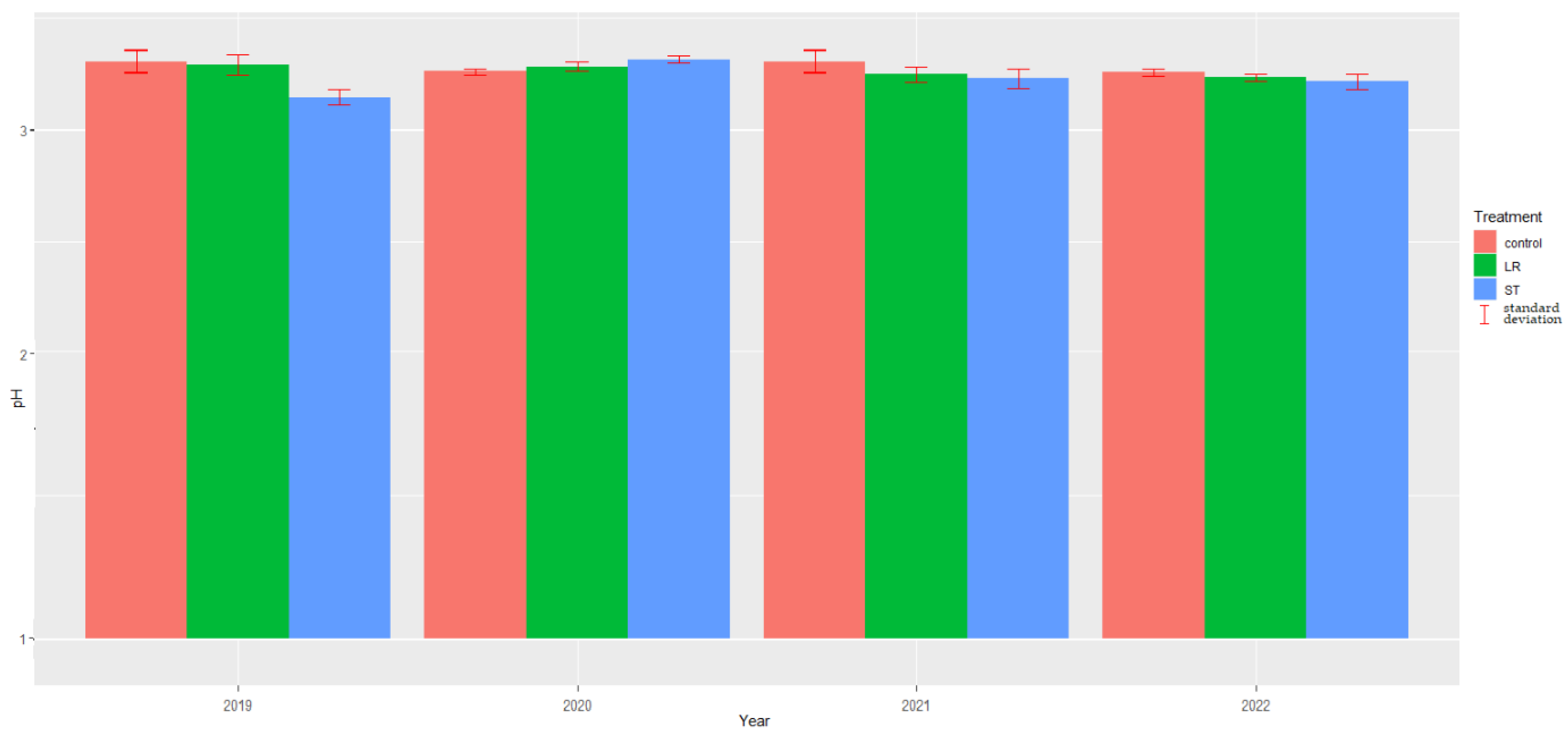
| Cultivar | Pinot Noir | Welschriesling | Yearly Statistics | ||||
|---|---|---|---|---|---|---|---|
| Year | Control | Short Topping | Leaf Removal | Control | Short Topping | Leaf Removal | |
| 2019 | 1.10 | 1.18 | 1.20 | 1.42 | 1.51 | 1.42 | |
| 1.45 | 1.26 | 1.17 | 1.44 | 1.55 | 1.51 | ||
| 1.24 | 1.18 | 1.27 | 1.40 | 1.36 | 1.64 | ||
| 1.37 | 1.13 | 1.39 | 1.50 | 1.39 | 1.54 | ||
| Average | 1.29 | 1.19 | 1.26 | 1.44 | 1.45 | 1.53 | 1.36 |
| Variance | 0.0235 | 0.0029 | 0.0096 | 0.0019 | 0.0084 | 0.0082 | 0.0224 |
| 2020 | 0.91 | 0.78 | 0.82 | 1.2 | 1.2 | 1.25 | |
| 0.76 | 0.88 | 0.88 | 1.19 | 1.23 | 1.34 | ||
| 0.77 | 0.84 | 0.79 | 1.14 | 1.1 | 1.13 | ||
| 0.88 | 0.81 | 0.87 | 1.02 | 1.17 | 1.23 | ||
| Average | 0.83 | 0.8275 | 0.84 | 1.1375 | 1.175 | 1.2375 | 1.01 |
| Variance | 0.0058 | 0.0018 | 0.0018 | 0.0068 | 0.0031 | 0.0074 | 0.0365 |
| 2021 | 0.81 | 0.63 | 0.42 | 1.67 | 1.57 | 1.68 | |
| 0.82 | 0.44 | 0.56 | 1.51 | 1.24 | 1.09 | ||
| 0.96 | 0.63 | 0.47 | 1.41 | 1.5 | 1.88 | ||
| 0.74 | 0.82 | 0.69 | 1.81 | 1.16 | 1.39 | ||
| Average | 0.8325 | 0.63 | 0.535 | 1.6 | 1.3675 | 1.51 | 1.08 |
| Variance | 0.0085 | 0.0241 | 0.0140 | 0.0311 | 0.0393 | 0.1189 | 0.2218 |
| 2022 | 1.15 | 1.20 | 1.22 | 1.8 | 1.89 | 1.75 | |
| 1.14 | 1.28 | 1.21 | 1.85 | 1.82 | 1.71 | ||
| 1.24 | 1.19 | 1.22 | 1.61 | 1.69 | 1.80 | ||
| 1.11 | 1.20 | 1.20 | 1.71 | 1.60 | 1.72 | ||
| Average | 1.16 | 1.2175 | 1.2125 | 1.7425 | 1.75 | 1.745 | 1.47 |
| Variance | 0.0031 | 0.0018 | 0.0001 | 0.0112 | 0.0169 | 0.0016 | 0.0836 |
| Average | 0.99 | 1.47 | |||||
| Variance | 0.07 | 0.06 | |||||
| Cultivar | Pinot Noir | Welshriesling | Yearly Statistics | ||||
|---|---|---|---|---|---|---|---|
| Year | Control | Leaf Removal | Short Topping | Control | Leaf Removal | Short Topping | |
| 2019 | 19.80 | 18.20 | 18.70 | 19.30 | 21.30 | 21.90 | |
| 20.90 | 18.40 | 19.40 | 22.70 | 21.10 | 22.50 | ||
| 19.40 | 17.90 | 17.50 | 24.00 | 19.10 | 19.50 | ||
| 19.50 | 18.00 | 18.40 | 23.90 | 21.00 | 19.30 | ||
| Average | 19.90 | 18.13 | 18.50 | 22.48 | 20.63 | 20.80 | 20.07 |
| Variance | 0.4733 | 0.0492 | 0.6200 | 4.8292 | 1.0492 | 2.6800 | 3.5091 |
| 2020 | 19.60 | 18.70 | 17.80 | 21.10 | 20.10 | 20.10 | |
| 19.40 | 18.80 | 19.20 | 21.40 | 20.00 | 20.40 | ||
| 19.20 | 18.00 | 18.40 | 20.90 | 20.50 | 20.10 | ||
| 18.80 | 18.80 | 17.40 | 21.30 | 19.90 | 20.30 | ||
| Average | 19.25 | 18.58 | 18.20 | 21.18 | 20.13 | 20.23 | 19.59 |
| Variance | 0.1167 | 0.1492 | 0.6133 | 0.0492 | 0.0692 | 0.0225 | 1.2251 |
| 2021 | 22.70 | 20.70 | 22.40 | 22.50 | 22.10 | 22.50 | |
| 23.10 | 21.70 | 21.50 | 22.90 | 21.10 | 22.90 | ||
| 21.50 | 19.80 | 21.70 | 22.60 | 22.20 | 21.50 | ||
| 21.90 | 22.20 | 21.60 | 22.70 | 21.50 | 21.70 | ||
| Average | 22.30 | 21.10 | 21.80 | 22.68 | 21.73 | 22.15 | 21.96 |
| Variance | 0.53 | 1.14 | 0.17 | 0.03 | 0.27 | 0.44 | 0.5938 |
| 2022 | 21.50 | 19.20 | 19.60 | 19.80 | 19.80 | 20.40 | |
| 21.30 | 18.50 | 20.30 | 20.90 | 20.30 | 21.70 | ||
| 21.40 | 18.40 | 20.20 | 22.00 | 20.50 | 18.70 | ||
| 19.70 | 21.20 | 19.50 | 20.80 | 20.70 | 18.90 | ||
| Average | 20.98 | 19.33 | 19.90 | 20.88 | 20.33 | 19.93 | 20.22 |
| Variance | 0.73 | 1.69 | 0.17 | 0.81 | 0.15 | 1.98 | 1.0678 |
| Average | 19.83 | 21.09 | |||||
| Variance | 2.3191 | 1.6348 | |||||
| Cultivar | Pinot Noir | Welshriesling | Yearly Statistics | ||||
|---|---|---|---|---|---|---|---|
| Year | Control | Leaf Removal | Short Topping | Control | Leaf Removal | Short Topping | |
| 2019 | 8.50 | 7.26 | 7.63 | 6.89 | 7.33 | 5.09 | |
| 9.54 | 7.25 | 6.82 | 6.06 | 6.22 | 7.11 | ||
| 8.50 | 7.20 | 9.12 | 7.65 | 7.72 | 7.51 | ||
| 8.74 | 8.41 | 8.09 | 6.17 | 6.6 | 6.64 | ||
| Average | 8.82 | 7.53 | 7.92 | 6.69 | 6.97 | 6.59 | 7.42 |
| Variance | 0.2432 | 0.3449 | 0.9210 | 0.5430 | 0.4638 | 1.1231 | 1.1084 |
| 2020 | 10.89 | 9.44 | 9.35 | 7.14 | 7.12 | 7.02 | |
| 8.78 | 9.06 | 8.27 | 6.78 | 6.79 | 6.79 | ||
| 10.37 | 8.53 | 8.11 | 7.03 | 7.37 | 7.53 | ||
| 10.53 | 9.09 | 9.58 | 8.05 | 7.14 | 7.2 | ||
| Average | 10.14 | 9.03 | 8.83 | 7.25 | 7.11 | 7.14 | 8.25 |
| Variance | 0.8724 | 0.1409 | 0.5550 | 0.3071 | 0.0570 | 0.0975 | 1.6696 |
| 2021 | 9.06 | 10.5 | 9.68 | 4.26 | 4.24 | 4.59 | |
| 8.89 | 8.05 | 9.54 | 4.43 | 4.69 | 5.5 | ||
| 8.3 | 8.4 | 8.55 | 5.39 | 5.78 | 6.23 | ||
| 9.84 | 8.05 | 7.82 | 4.27 | 6.91 | 5.07 | ||
| Average | 9.02 | 8.75 | 8.90 | 4.59 | 5.41 | 5.35 | 7.00 |
| Variance | 0.4031 | 1.3883 | 0.7690 | 0.2923 | 1.4247 | 0.4843 | 4.4208 |
| 2022 | 6.84 | 6.60 | 6.97 | 4.94 | 5.56 | 5.78 | |
| 6.8 | 6.71 | 7.00 | 4.84 | 5.26 | 5.05 | ||
| 6.63 | 6.10 | 6.04 | 5.33 | 5.03 | 5.46 | ||
| 6.79 | 6.30 | 6.73 | 5.28 | 5.05 | 5.46 | ||
| Average | 6.77 | 6.43 | 6.69 | 5.10 | 5.23 | 5.44 | 5.94 |
| Variance | 0.0086 | 0.0777 | 0.1995 | 0.0595 | 0.0607 | 0.0895 | 0.5771 |
| Average | 8.23 | 6.07 | |||||
| Variance | 1.6307 | 1.1942 | |||||
| Cultivar | Pinot Noir | Welshriesling | Yearly Statistics | ||||
|---|---|---|---|---|---|---|---|
| Year | Control | Leaf Removal | Short Topping | Control | Leaf Removal | Short Topping | |
| 2019 | 3.31 | 3.20 | 3.30 | 3.29 | 3.28 | 3.21 | |
| 3.36 | 3.21 | 3.34 | 3.3 | 3.32 | 3.23 | ||
| 3.27 | 3.10 | 3.32 | 3.4 | 3.12 | 3.28 | ||
| 3.24 | 3.08 | 3.31 | 3.27 | 3.2 | 3.23 | ||
| Average | 3.30 | 3.15 | 3.32 | 3.32 | 3.23 | 3.24 | 3.26 |
| Variance | 0.0027 | 0.0045 | 0.0003 | 0.0034 | 0.0079 | 0.0009 | 0.0063 |
| 2020 | 3.27 | 3.4 | 3.29 | 3.42 | 3.26 | 3.49 | |
| 3.28 | 3.3 | 3.27 | 3.41 | 3.34 | 3.45 | ||
| 3.22 | 3.18 | 3.24 | 3.37 | 3.19 | 3.54 | ||
| 3.26 | 3.28 | 3.24 | 3.32 | 3.21 | 3.52 | ||
| Average | 3.26 | 3.29 | 3.26 | 3.38 | 3.25 | 3.50 | 3.32 |
| Variance | 0.0007 | 0.0081 | 0.0006 | 0.0021 | 0.0045 | 0.0015 | 0.0108 |
| 2021 | 3.53 | 3.32 | 3.31 | 3.21 | 3.26 | 3.46 | |
| 3.46 | 3.29 | 3.32 | 3.4 | 3.3 | 3.46 | ||
| 3.44 | 3.22 | 3.28 | 3.33 | 3.25 | 3.56 | ||
| 3.29 | 3.25 | 3.36 | 3.52 | 3.22 | 3.46 | ||
| Average | 3.43 | 3.27 | 3.32 | 3.37 | 3.26 | 3.49 | 3.35 |
| Variance | 0.0102 | 0.0019 | 0.0011 | 0.0168 | 0.0011 | 0.0025 | 0.0115 |
| 2022 | 3.32 | 3.24 | 3.28 | 3.34 | 3.13 | 3.53 | |
| 3.44 | 3.35 | 3.28 | 3.32 | 3.3 | 3.44 | ||
| 3.25 | 3.31 | 3.34 | 3.17 | 3.23 | 3.51 | ||
| 3.22 | 3.28 | 3.24 | 3.4 | 3.21 | 3.57 | ||
| Average | 3.31 | 3.30 | 3.29 | 3.31 | 3.22 | 3.51 | 3.32 |
| Variance | 0.0096 | 0.0022 | 0.0017 | 0.0096 | 0.0049 | 0.0030 | 0.0127 |
| Average | 3.29 | 3.34 | |||||
| Variance | 0.0065 | 0.0150 | |||||
| Cultivar | Pinot Noir | Welshriesling | Yearly Statistics | ||||
|---|---|---|---|---|---|---|---|
| Year | Control | Leaf Removal | Short Topping | Control | Leaf Removal | Short Topping | |
| 2019 | 0.00 | 5.00 | 10.00 | 0.00 | 5.00 | 0.00 | |
| 0.00 | 5.00 | 7.00 | 0.00 | 5.00 | 0.00 | ||
| 0.00 | 5.00 | 5.00 | 0.00 | 5.00 | 0.00 | ||
| 0.00 | 5.00 | 5.00 | 0.00 | 5.00 | 0.00 | ||
| Average | 0.00 | 5.00 | 6.75 | 0.00 | 5.00 | 0.00 | 2.79 |
| Variance | 0.0000 | 0.0000 | 5.5833 | 0.0000 | 0.0000 | 0.0000 | 9.2156 |
| 2020 | 2.00 | 15.00 | 5.00 | 0.00 | 5.00 | 0.00 | |
| 3.00 | 15.00 | 0.00 | 0.00 | 10.00 | 0.00 | ||
| 3.00 | 15.00 | 5.00 | 0.00 | 5.00 | 0.00 | ||
| 3.00 | 15.00 | 2.00 | 0.00 | 10.00 | 0.00 | ||
| Average | 2.75 | 15.00 | 3.00 | 0.00 | 7.50 | 0.00 | 4.71 |
| Variance | 0.2500 | 0.0000 | 6.0000 | 0.0000 | 8.3333 | 0.0000 | 30.5634 |
| 2021 | 0.00 | 10.00 | 3.00 | 0.00 | 0.00 | 0.00 | |
| 0.00 | 10.00 | 5.00 | 0.00 | 0.00 | 0.00 | ||
| 0.00 | 10.00 | 3.00 | 0.00 | 0.00 | 0.00 | ||
| 0.00 | 10.00 | 0.00 | 0.00 | 0.00 | 0.00 | ||
| Average | 0.00 | 10.00 | 2.75 | 0.00 | 0.00 | 0.00 | 2.13 |
| Variance | 0.0000 | 0.0000 | 4.2500 | 0.0000 | 0.0000 | 0.0000 | 14.5489 |
| 2022 | 10.00 | 5.00 | 2.00 | 5.00 | 0.00 | 0.00 | |
| 10.00 | 10.00 | 2.00 | 10.00 | 0.00 | 0.00 | ||
| 10.00 | 5.00 | 3.00 | 10.00 | 0.00 | 0.00 | ||
| 10.00 | 5.00 | 2.00 | 5.00 | 0.00 | 0.00 | ||
| Average | 10.00 | 6.25 | 2.25 | 7.50 | 0.00 | 0.00 | 4.33 |
| Variance | 0.0000 | 6.2500 | 0.2500 | 8.3333 | 0.0000 | 0.0000 | 17.1884 |
| Average | 5.31 | 1.67 | |||||
| Variance | 20.6024 | 9.9291 | |||||
| Cultivar | Effect | Yield | Sugar Content of the Must | Titratable Acids | pH | Botrytis Infection |
|---|---|---|---|---|---|---|
| Pinot noir | Treatment | . | *** | ** | * | *** |
| Year | *** | *** | *** | *** | *** | |
| Treatment:Year | ** | . | *** | |||
| Welshriesling | Treatment | *** | . | *** | ||
| Year | *** | *** | *** | *** | ||
| Treatment:Year | . | *** |
Disclaimer/Publisher’s Note: The statements, opinions and data contained in all publications are solely those of the individual author(s) and contributor(s) and not of MDPI and/or the editor(s). MDPI and/or the editor(s) disclaim responsibility for any injury to people or property resulting from any ideas, methods, instructions or products referred to in the content. |
© 2023 by the authors. Licensee MDPI, Basel, Switzerland. This article is an open access article distributed under the terms and conditions of the Creative Commons Attribution (CC BY) license (https://creativecommons.org/licenses/by/4.0/).
Share and Cite
Jahnke, G.; Szőke, B.Á.; Steckl, S.; Szövényi, Á.P.; Knolmajerné Szigeti, G.; Németh, C.; Jenei, B.G.; Nyitrainé Sárdy, D.Á. Delay in the Ripening of Wine Grapes: Effects of Specific Phytotechnical Methods on Harvest Parameters. Agronomy 2023, 13, 1963. https://doi.org/10.3390/agronomy13081963
Jahnke G, Szőke BÁ, Steckl S, Szövényi ÁP, Knolmajerné Szigeti G, Németh C, Jenei BG, Nyitrainé Sárdy DÁ. Delay in the Ripening of Wine Grapes: Effects of Specific Phytotechnical Methods on Harvest Parameters. Agronomy. 2023; 13(8):1963. https://doi.org/10.3390/agronomy13081963
Chicago/Turabian StyleJahnke, Gizella, Barna Árpád Szőke, Szabina Steckl, Áron Pál Szövényi, Gyöngyi Knolmajerné Szigeti, Csaba Németh, Botond Gyula Jenei, and Diána Ágnes Nyitrainé Sárdy. 2023. "Delay in the Ripening of Wine Grapes: Effects of Specific Phytotechnical Methods on Harvest Parameters" Agronomy 13, no. 8: 1963. https://doi.org/10.3390/agronomy13081963
APA StyleJahnke, G., Szőke, B. Á., Steckl, S., Szövényi, Á. P., Knolmajerné Szigeti, G., Németh, C., Jenei, B. G., & Nyitrainé Sárdy, D. Á. (2023). Delay in the Ripening of Wine Grapes: Effects of Specific Phytotechnical Methods on Harvest Parameters. Agronomy, 13(8), 1963. https://doi.org/10.3390/agronomy13081963







